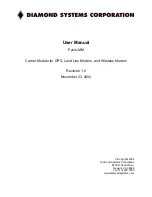
CHAPTER 40 Automatic Provisioning
Mediant 4000 SBC | User's Manual
●
Startup Script File:
Contains only CLI commands and configures all the device's
functionality (except commands such as show, debug or copy). The file updates the
device's configuration according to the configuration settings in the file and sets all other
parameters that are not included in the file to factory defaults. The file causes two device
resets to apply the settings. Therefore, the file typically contains the Automatic Update
settings and other configuration settings that require a device reset. The URL of the server
where this file is located is configured by the CLIStartupScriptURL ini file parameter or CLI
command, configure system > automatic-update > startup-script <URL>.
●
You can use any filename extension for the CLI script files.
●
The CLI Startup Script file is not supported when the device operates in HA mode.
File Location for Automatic Update
The files for updating the device can be stored on any standard Web (HTTP/S), TFTP, or FTP
server. The files can be loaded periodically to the device using HTTP/S, TFTP, or FTP. This
mechanism can be used even when the device is installed behind NAT and firewalls. The
Automatic Update feature is done per file and configured by specifying the file name and URL
address of the provisioning server where the file is located. If the device needs to authenticate itself
with the server, you can use the same parameters to configure the authentication username and
password (for more information, see
Access Authentication with HTTP Server
on page 702). For a
description of the parameters for configuring the URLs of the servers of the files, see
Below are examples for configuring the file names and their URLs for Automatic Update:
■
ini File:
IniFileURL = 'http://www.corp.com/configuration.ini'
CptFileURL = 'http://www.corp.com/call_progress.dat'
AutoCmpFileUrl = 'http://www.corp.com/SIP_F7.20A.008.cmp
FeatureKeyURL = 'https://www.company.com/License_Key.txt'
■
CLI:
# configure system
(config-system)# automatic update
(automatic-update)# cli-script https://company.com/cli/<MAC>
(automatic-update)# startup-script https://company.com/startup/<MAC>
(automatic-update)# voice-configuration http://www.company.com/configuration.ini
(automatic-update)# call-progress-tones http://www.company.com/call_progress.dat
(automatic-update)# feature-key http://www.company.com/License_Key.txt
(automatic-update)# auto-firmware http://www.company.com/SIP_F7.20A.008.cmp
For configuration files, the file name in the URL can automatically contain the device's
MAC address for enabling the device to download a file unique to the device. For more
information, see
MAC Address Placeholder in Configuration File Name
.
MAC Address Placeholder in Configuration File Name
You can configure the file name of the configuration file in the URL to automatically include the
MAC address of the device. As described in
File Location for Automatic Update
- 698 -
Summary of Contents for Mediant 4000 SBC
Page 1: ...User s Manual AudioCodes Series of Session Border Controllers SBC Mediant 4000 SBC Version 7 2...
Page 40: ...Part I Getting Started with Initial Connectivity...
Page 48: ...Part II Management Tools...
Page 113: ...Part III General System Settings...
Page 118: ...Part IV General VoIP Configuration...
Page 525: ...Part V Session Border Controller Application...
Page 654: ...Part VI Cloud Resilience Package...
Page 663: ...Part VII High Availability System...
Page 685: ...Part VIII Maintenance...
Page 759: ...Part IX Status Performance Monitoring and Reporting...
Page 844: ...Part X Diagnostics...
Page 888: ...Part XI Appendix...
















































